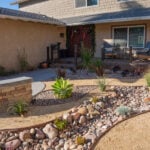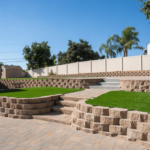In the dynamic and ever-evolving world of landscaping, the resonant call for sustainable and eco-friendly practices echoes louder than ever before. As societies globally embrace a heightened sense of environmental consciousness, the pursuit of landscaping solutions that champion eco-friendly construction methods has emerged as a top priority for discerning homeowners and forward-thinking businesses alike.
Moreover, this comprehensive guide serves as a beacon for those seeking a deeper understanding of sustainable landscaping, transcending traditional practices. We embark on a journey into the heart of innovative techniques, eco-conscious materials, and cutting-edge designs that not only elevate the aesthetic appeal of outdoor spaces but also play a pivotal role in nurturing a healthier planet. From thoughtfully curated plant selections to the mindful use of recycled and upcycled materials, we delve into every facet of sustainable landscaping, empowering you to make informed decisions that align with both your aesthetic preferences and environmental values.
In a landscape where every choice we make has the potential to shape the future of our planet, this guide is a roadmap to transformative practices. Beyond mere aesthetics, it is a testament to the power of landscaping as a force for positive change. Join us as we explore the dynamic intersection of creativity and environmental responsibility, providing you with the knowledge and inspiration to cultivate outdoor spaces that not only reflect your personal style but also contribute meaningfully to the well-being of our shared home—Earth.
Understanding Eco-Friendly
What is Eco-Friendly Construction in Landscaping?
Eco-friendly landscaping involves the use of sustainable practices that minimize the environmental impact of construction and maintenance. This includes utilizing renewable resources, reducing waste, and incorporating designs that support local ecosystems.
Importance of Eco-Friendly
Embracing eco-friendly landscaping practices extends far beyond the creation of visually appealing outdoor spaces; it serves as a powerful catalyst for positive environmental change. From reducing water consumption to fostering biodiversity and mitigating the impacts of climate change, eco-friendly landscaping plays a pivotal role in creating a greener, healthier world.
Sustainable Materials
Recycled and Upcycled
Reclaimed Wood for Decks and Structures:
- Consider the character and charm that reclaimed wood brings to outdoor spaces. Salvaged wood from old barns, warehouses, or shipping pallets can be repurposed to construct decks, pergolas, or fencing. Choosing reclaimed wood not only reduces the need for new timber but also prevents old wood from ending up in landfills.
Recycled Glass Mulch:
- Crushed glass in various colors can be used as mulch around plant beds and pathways. Besides adding a touch of aesthetic brilliance, recycled glass mulch also reflects sunlight, providing an additional layer of solar heat reflection that benefits plant root zones.
Recycled Metal Art and Sculptures:
- Infuse artistic flair into landscaping projects by incorporating recycled metal into sculptures and art installations. Old metal pipes, car parts, or discarded machinery can be transformed into eye-catching focal points. These unique pieces not only contribute to the aesthetics of the landscape but also serve as a reminder of the transformative power of repurposing materials.
Crushed Concrete for Driveways and Paths:
- Crushed concrete, derived from old demolished structures, offers a sustainable alternative for driveways and pathways. This material provides a solid and stable surface, showcasing the durability of recycled materials. Using crushed concrete not only reduces the demand for new aggregates but also minimizes the environmental impact of concrete disposal.
Reclaimed Bricks and Pavers:
- Salvaged bricks and pavers, sourced from old buildings or construction sites, can be repurposed for pathways, patios, or garden borders. These reclaimed materials not only exude character and charm but also contribute to the conservation of energy and resources that would otherwise be expended in manufacturing new bricks.
Eco-Friendly Planting and Design
Support for Local Ecosystems:
- Native plants are naturally adapted to the local climate, soil conditions, and ecosystem dynamics.. Native plants have evolved alongside local fauna, forming essential relationships that support biodiversity and ecological balance.
Biodiversity Enhancement:
- Native plants play a vital role in promoting biodiversity. They provide habitat and food sources for a variety of local wildlife, including birds, insects, and small mammals.
Pollinator Attraction:
- Native plants are well-suited to attract and support local pollinators, such as bees, butterflies, and hummingbirds. These plants often have specific adaptations, such as flower shapes, colors, and scents, that align with the preferences of local pollinators. The presence of native plants in landscaping designs helps sustain pollinator populations, contributing to the pollination of other plants in the area.
Water Efficiency:
- Native plants are inherently adapted to local rainfall patterns and soil conditions. As a result, they generally require less water than non-native species once established. Reduced water needs not only conserve water resources but also contribute to water efficiency and resilience in the face of changing climate conditions.
Low Maintenance Requirements:
- Native plants are well-adapted to local environmental conditions, which often translates to lower maintenance needs. These plants have evolved to thrive in the specific climate, reducing the reliance on fertilizers, pesticides, and excessive watering. Choosing native species can lead to landscapes that are not only environmentally friendly but also more cost-effective and easier to maintain over time.
Preservation of Genetic Diversity:
- Native plant species contribute to the preservation of genetic diversity within ecosystems. Preserving genetic diversity is critical for combating environmental stressors and ensuring the long-term health of ecosystems.
Sustainable Irrigation Practices
Drip Irrigation Systems:
- Drip irrigation is a targeted and efficient method of delivering water directly to the roots of plants. This system consists of a network of tubes and emitters that release water in controlled amounts.
Smart Irrigation Controllers:
- Smart irrigation controllers leverage technology to optimize watering schedules based on real-time weather data, soil moisture levels, and plant requirements.
Rainwater Harvesting for Irrigation:
- Designing landscapes that capture and utilize rainwater presents a sustainable approach to irrigation. Rainwater harvesting involves collecting and storing rainwater for later use.
Green Building Techniques
Living Walls and Green Roofs
These innovative installations go beyond mere aesthetic appeal, offering a myriad of environmental benefits that contribute to energy efficiency, improved air quality, and enhanced insulation in both residential and commercial settings.
Living Walls:
- Living walls, or vertical gardens, are vertical structures adorned with an array of plants and vegetation.
Green Roofs:
- Green roofs involve the cultivation of vegetation on the roof surfaces of buildings,
Energy-Efficient Lighting
Environmental Impact:
- Traditional lighting sources, such as incandescent bulbs, can be energy-intensive and contribute to greenhouse gas emissions. Therefore, opting for energy-efficient alternatives helps mitigate these environmental concerns and promotes a greener, more sustainable landscape.
LED Lighting Technology:
- LEDs consume significantly less energy compared to traditional bulbs, resulting in lower electricity bills and extended product lifespans. Additionally, LEDs are mercury-free, reducing the environmental impact associated with disposal.
Solar-Powered Fixtures:
- These fixtures incorporate solar panels that convert sunlight into electrical energy, stored in rechargeable batteries for use during the night. By relying on renewable solar power, these fixtures eliminate the need for additional electricity consumption and further contribute to sustainable landscaping practices.
Reduced Light Pollution:
- Energy-efficient lighting solutions, such as LEDs, can be effectively directed, minimizing light spill and reducing light pollution. This not only benefits the surrounding ecosystem by preserving natural darkness but also enhances the visibility and aesthetic appeal of specific landscape features without negatively impacting the broader environment.
Cost Savings:
- Beyond their environmental advantages, energy-efficient lighting solutions translate into cost savings for homeowners and businesses. Moreover, the initial investment in energy-efficient technologies is often outweighed by the long-term financial benefits and reduced maintenance costs.
Customization and Control:
- With features such as programmable timers, dimmers, and color options, property owners can tailor the lighting to suit specific needs, creating ambiance, and enhancing security without unnecessary energy consumption.
Beauty Meets Sustainability
In conclusion, embracing eco-friendly construction in landscaping is not just a trend but a responsible choice that positively impacts the environment. By adopting sustainable practices, utilizing eco-friendly materials, and designing landscapes with biodiversity in mind, we can create outdoor spaces that are not only aesthetically pleasing but also contribute to a greener, more sustainable future. Hence, let this guide inspire you to embark on a journey towards eco-conscious landscaping, where beauty meets sustainability.






